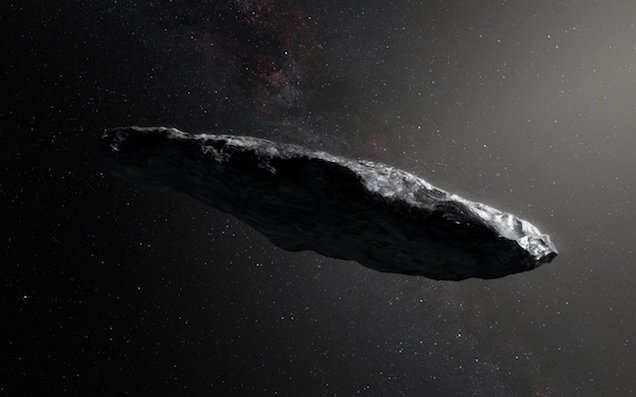
A lot of things happened last year. Probably. I personally am doing my best to put the events of the foul year 2018 behind me, but there is at least one thing which I will not soon forget: Harvard‘s astronomy chair co-authoring a paper suggesting that the interstellar object ‘Oumuamua could be an alien probe powered by a solar sail.
[jwplayer gvkTjsCy]
‘Oumuamua (if you’re not familiar) is a narrow chunk of something reddish that is somewhere between 100 metres and one kilometre long. ‘Oumuamua was first spotted back in 2017, after which we realised that this tumbling object had come into our solar system from outside it and was quickly on its way to leave again. Being the first object from outside the solar system spotted inside it already made ‘Oumuamua pretty exciting, but what made it even more exciting than that was when it exhibited acceleration from some other source than gravitational pull.
In a paper titled Could Solar Radiation Pressure Explain ‘Oumuamua’s Peculiar Acceleration?, published in November in the journal The Astrophysical Journal Letters, Shmuel Bialy and Abraham Loeb explored the possibility that the sudden and unexpected acceleration of ‘Oumuamua could be due to it being “a thin object accelerated by Solar radiation pressure”. A bit dry? Sure. How does this part tinkle your ivories, though:
Alternatively, a more exotic scenario is that ‘Oumuamua may be a fully operational probe sent intentionally to Earth vicinity by an alien civilization. . . . This discrepancy is readily solved if ‘Oumuamua does not follow a random trajectory but is rather a targeted probe.
That’s what I thought.
The duo’s suggestion received a fair bit of criticism, most notably from Robert Weryk, who discovered ‘Oumuamua in the first place. Weryk called Loeb’s hypothesis “wild speculation“, suggesting that rather it was “a comet that had a bit of outgassing that wasn’t visible from the ground, which is why it didn’t appear to be a comet“. Outgassing can cause comets to accelerate when they pass by the sun as gases are ejected from the comet, propelling them somewhat. Except research has indicated that ‘Oumuamua is not a comet, and that the outgassing required to account for that acceleration would also likely have torn it apart, and yet it remains intact.
Speaking to Haaretz, Loeb defended his theory. Loeb said that if he was wrong, he might be “committing image suicide“, but if he’s right it would be one of the greatest discoveries in human history:
The only hypothesis I could think of is a push from solar radiation pressure. For that to work, the object would have to be very thin, less than a millimeter thick, in other words a type of pancake. In addition, the Spitzer Space Telescope found no evidence of heat emission from the object, and that means that it is at least 10 times more reflective than a typical comet or asteroid. What we have, then, is a thin, flat, shiny object. So I arrived at the idea of a solar sail: A solar sail is a spaceship that uses the sun for propulsion. Instead of using fuel, it is propelled ahead by reflecting light. In fact, it’s a technology that our civilization is developing at this very time.
Loeb said that if indeed it was an alien prove, they likely didn’t know that we were here:
We have no way of knowing whether it’s active technology, or a spaceship that is no longer operative and is continuing to float in space. But if Oumuamua was created together with a whole population of similar objects that were launched randomly, the fact that we discovered it means that its creators launched a quadrillion probes like it to every star in the Milky Way.
Of course, the randomness is significantly reduced if we assume that Oumuamua was a reconnaissance mission that was deliberately sent to the inner solar system – namely, to the habitable region where life would be feasible. But we need to remember that humanity didn’t broadcast anything tens of thousands of years ago, when the object was still in interstellar space. They didn’t know there was intelligent life here. Which is why I think it’s just a fishing expedition.
In the piece, Loeb said that it was a form of hubris to assume that there isn’t intelligent life out there in some form:
Anyone who claims that we are unique and special is guilty of arrogance. My premise is cosmic modesty. Today, thanks to the Kepler Space Telescope, we know that there are more planets like Earth than there are grains of sand on all the shores of all the seas. Imagine a king who manages to seize control of a piece of another country in a horrific battle, and who then thinks of himself as a great, omnipotent ruler. And then imagine that he succeeds in seizing control of all the land, or of the entire world: It would be like an ant that has wrapped its feelers around one grain of sand on a vast seashore. It’s meaningless. I assume that we are not the only ants on the shore, that we are not alone.
Look, fair enough.
You can and should read the entire interview right here.
It’s definitely aliens.







